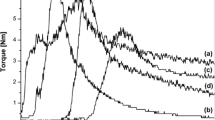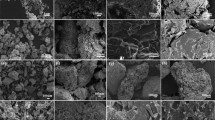Abstract
The search for highly productive agriculture has considerably increased the use of fertilizers, becoming a worrying source of environmental and health risks. This work reports the preparation and characterization of a controlled phosphorus release system using a multi-layer blend of starch and latex, in different proportions. Infrared spectroscopy and thermogravimetric analysis were used to evaluate the incorporation and interaction of phosphorus with the polymeric matrix. The mechanical properties, and transport properties were evaluated as a function of the addition of latex and mono-ammonium phosphate (MAP) to the starch. The Zero order, Peppas-Sahlin and Korsmeyer-Peppas kinetic models were applied. The results showed that phosphorus is released between 58% to 80% in the analyzed time. The release mechanism depends on the blend composition and the amount of incorporated MAP, indicating that it is possible to adapt the material formulation to meet specific soil needs.
Graphic Abstract







Similar content being viewed by others
References
United Nations UN (2019) World population prospects 2019. https://population.un.org/wpp/ Accessed 30 January 2020
Chen J, Lü S, Zhang Z, Zhao X, Li X, Ning P, Liu M (2018) Environmentally friendly fertilizers: a review of materials used and their effects on the environment. Sci Total Environ 613:829–839
Irfan SA, Razali R, Kushaari K, Manson N, Azeem B, Versypt ANF (2018) A review of mathematical modeling and simulation of controlled-release fertilizers. J Control Release 271:45–54
Li H, Li Y, Xu Y, Lu X (2020) Biochar phosphorus fertilizer effects on soil phosphorus availability. Chemosphere 244:125471
Fertahi S, Bertrand I, Ilsouk M, Oukarroum A, Amjoud M, Zeroual Y, Barakat A (2020) New generation of controlled release phosphorus fertilizers based on biological macromolecules: effect of formulation properties on phosphorus release. Int J Biol Macromol 143:153–162
Azeem B, Kushaari K, Man ZB, Basit A, Thanh TH (2014) Review on materials & methods to produce controlled release coated urea fertilizer. J Control Release 181(1):11–21
Bortoletto-Santos R, Guimarães GGF, Roncato Junior V, Cruz DF (2020) Biodegradable oil-based polymeric coatings on urea fertilizer: N release kinetic transformations of urea in soil. Sci Agric 77(1):1–9
Trenkel M (2010) Slow and controlled-release and stabilized fertilizers: an option for enhancing nutrient efficiency in agriculture. International Fertilizer Industry Association. Paris
Costa TP, Westphalen G, Nora FBD, Silva BZ, Rosa GS (2019) Technical and environmental assessment of coated urea production with a natural polymeric suspension in spouted bed to reduce nitrogen losses. J Cleaner Production 222:324–334
Ye HM, Li HF, Wang CS, Yang Huang G, Meng X, Zhou Q (2020) Degradable polyester/urea inclusion complex applied as a facile and environment-friendly strategy for slow-release fertilizer: performance and mechanism. Chem Eng J 381:122704
Vudjung C, Saengsuwan S (2018) Biodegradable IPN hydrogels based on pre-vulcanized natural rubber and cassava starch as coating membrane for environment-friendly slow-release urea fertilizer. J Polym Environ 26(9):3967–3980
Mali S, Grossmann MVE, Yamashita F (2010) Starch films: production. Properties and potential of utilization. Semina: Ciências Agrárias 31(1):137–156
American Society for Testing and Materials – ASTM (1996). Method for water absorption of plastics – D570. Annual book of ASTM. Philadelphia
Association of Official Analytical Chemists – AOAC (1990). Official Methods of analysis: 930.04. Moisture Content in Plants
Scope BS, Pretto GL, Postiglione Correa JI, Baldasso C, Dettmer A, Campomanes Santana RM (2020) Starch-leather waste gelatin films cross-linked with glutaraldehyde. J Polym Environ 28(7):1974–1984
American Society for Testing and Materials – ASTM (1995) Standard test method for water vapor transmission of material – E96–95. Annual book of ASTM, Philadelphia
American Society for Testing and Materials – ASTM (1996) Standard test methods for tensile properties of thin plastic sheeting, D882-91. Annual book of ASTM, Philadelphia
Standard Methods Online – Standard methods for the examination of water and wastewater-4500-P F. Automated Ascorbic Acid Reduction Method
Pereira TS, França D, Souza CF, Faez R (2020) Chitosan-sugarcane bagasse microspheres as fertilizer delivery: on/off water availability system. J Polym Environ 28:2977–2987
Nooeaid P, Chuysinuan P, Pitakdantham W, Aryuwananon D, Techasaku S, Dechtrirat D (2020) Eco-friendly polyvinyl alcohol/polylactic acid core/shell structured fibers as controlled-release fertilizers for sustainable agriculture. J Polym Environ. https://doi.org/10.1007/s10924-020-01902-9
Embrapa. Centro Nacional de Pesquisa de Solos (1997) Manual de métodos de análise de solo. In: Rio de Janeiro
Lopes CM, Lobo JMS, Costa P (2005) Modified release of drug delivery systems: hydrophilic polymers. Braz J Pharmaceut Sci 41(2):143–154
Ritger P, Peppas NA (1987) A simple equation for description of solute release. II. Fickian and anomalous release from swellable devices. J Control Release 5(1):37–42
Peppas NA, Sahlin JJ (1989) A simple equation for the description of solute release. III. Coupling of diffusion and relaxation. Int J Pharm 57:169–172
Dankar I, Haddarah A, Omar FE, Pujolà M, Sepulcre F (2018) Characterization of food additive-potato starch complexes by FTIR and X-ray diffraction. Food Chem 260:7–12
Capron I, Robert P, Colonna P, Brogly M, Planchot V (2007) Starch in rubbery and glassy states by FTIR spectroscopy. Carbohydr Polym 68(2):249–259
Warren FJ, Gidley MJ, Flanagan BM (2016) Infrared spectroscopy as a tool to characterize starch ordered structure—a joint FTIR–ATR, NMR, XRD and DSC study. Carbohydr Polym 139:35–42
Chen B, Dang L, Zhang X, Fang W, Hou M, Liu T, Wang Z (2017) Physicochemical properties and micro-structural characteristics in starch from kudzu root as affected by cross-linking. Food Chem 219:93–101
Silverstein RM, Webster FX (2007) Spectrometric identification of organic compounds. LTC Editora, Rio de Janeiro
Moustafa YM, El-Egili K (1988) Infrared spectra of sodium phosphate glasses. J Non-Cryst Solids 240:144–153
Dong H, Vasanthan T (2020) Effect of phosphorylation techniques on structural, thermal, and pasting properties of pulse starches in comparison with corn starch. Food Hydrocoll 109:106078
IUPAC (1997) Compendium of chemical terminology. Blackwell, Oxford
Johns J, Rao V (2008) Characterization of natural rubber latex/chitosan blends. Int J Polym Anal Charact 13:280–291
Miljković J, Grmuša I, Điporović M, Kačarević-Popović Z (2005) The influence of fire retardants on the properties of beech and poplar veneers and plywood. lasnik Sumarskog fakulteta 92:111–124
Wongsagonsup R, Pujchakarn T, Jitrakbumrung S, Chaiwat W, Fuongfuchat A, Varavinit S, Suphantharika M (2014) Effect of cross-linking on physicochemical properties of tapioca starch and its application in soup product. Carbohydr Polym 101:656–665
Xie Y, Zhang B, Li MN, Chen HQ (2019) Effects of cross-linking with sodium trimetaphosphate on structural and adsorptive properties of porous wheat starches. Food Chem 289:187–194
Singh AV, Nath LK (2012) Synthesis and evaluation of physicochemical properties of cross-linked sago starch. Int J Biol Macromol 50(1):14–18
Merino D, Gutiérrez TJ, Alvare VA (2019) Potential agricultural mulch films based on native and phosphorylated corn starch with and without surface functionalization with chitosan. J Polym Environ 27:97–105
Gutiérrez TJ, Morales NJ, Pérez E, Tapia MS, Famá L (2015) Physico-chemical properties of edible films derived from native and phosphated cush-cush yam and cassava starches. Food Packag Shelf Life 3:1–8
Deetae P, Shobsngob S, Varanyanond W, Chinachoti P, Naivikul O, Varavinit S (2008) Preparation, pasting properties and freeze–thaw stability of dual modified crosslink-phosphorylated rice starch. Carbohydr Polym 73(2):351–358
Landerito NA, Wang YJ (2005) Preparation and properties of starch phosphates using waxy, common, and high-amylose corn starches. II. Reactive extrusion method. Cereal Chem 82(3):271–276
Gutiérrez TJ, Morales NJ, Tapia MS, Pérez E, Famá L (2015) Corn starch 80:20 “waxy”: regular, “native” and phosphated, as bio-matrixes for edible films. Procedia Mater Sci 8:304–310
Haim PG, Dimenstein L (2017) Controlled Release Fertilizers (CRF). Agrocote/Agroblen
Shaviv A, Raban S, Zaidel E (2003) Modeling controlled nutrient release from polymer coated fertilizers: diffusion release from single granules. Environ Sci Technol 37(10):2251–2256
Machado BAS, Nunes IL, Pereira FV, Druzian JI (2012) Development and evaluation of the effectiveness of biodegradable films of cassava starch with nanocelulose as reinforcement and yerba mate extract as an additive antioxidante. Ciência Rural 42(11):2085–2091
Chen C, Tao S, Qiu X, Ren X, Hu S (2013) Long-alkane-chain modified N-ph-haloyl chitosan membranes with controlled permeability. Carbohyd Polym 91(1):269–276
Wei Y, Li J, Li Y, Zhao B, Zhang L, Yang X, Chang J (2017) Research on permeability coefficient of a polyethylene controlled-release film coating for urea and relevant nutrient release pathways. Polym Test 59:90–98
Larotonda FD, Matsui KN, Sobral PJA, Laurindo JB (2005) Hygroscopicity and water vapor permeability of Kraft paper impregnated with starch acetate. J Food Eng 71:394–402
Fan H, Ji N, Zhao M, Xiong L, Sun Q (2016b) Characterization of starch films impregnated with starch nanoparticles prepared by 2.2.6.6 tetramethylpiperidine-1-oxyl (TEMPO)-mediated oxidation. Food Chem 192:865–872
Bertuzzi MA, Vidaurre EFC, Armanda M, Gottifredi JC (2007) Water vapor permeability of edible starch based films. J Food Eng 80(3):972–978
Gluck-Hirsch J, Kokini JL (1997) Determination of molecular weight between cross-links of waxy maize starches using the theory of rubber elasticity. J Rheol 41:129–139
Huber KC, Bemiller JN (2001) Location of sites of reaction within starch granules. Cereal Chem 78:173–180
Choi SG, Kerr WL (2004) Swelling characteristics of native and chemically modified wheat starches as a function of heating temperature and time. Starch 56:181–189
Naz MY, Sulaiman S (2017) Attributes of natural and synthetic materials pertaining to slow-release urea coating industry. Rev Chem Eng 33(3):293–308
Acknowledgments
The authors would like to thank the Conselho Nacional de Desenvolvimento Científico e Tecnológico (CNPq – Brazil), Coordenação de Aperfeiçoamento de Pessoal de Nível Superior (CAPES – Brazil) and Fundação Araucária – Brazil for their financial support, and also the Electronic Microscopy and Microanalysis Laboratory – LMEM, Spectroscopy Laboratory – ESPEC and X-Ray Analysis Laboratory – LARX (CMLP – UEL).
Author information
Authors and Affiliations
Corresponding author
Additional information
Publisher’s Note
Springer Nature remains neutral with regard to jurisdictional claims in published maps and institutional affiliations.
Rights and permissions
About this article
Cite this article
Góes, M.M., Merci, A., Andrello, A.C. et al. Design and Application of Multi-layer Starch-Latex Blends as Phosphorous Delivery System. J Polym Environ 29, 2000–2012 (2021). https://doi.org/10.1007/s10924-020-02018-w
Accepted:
Published:
Issue Date:
DOI: https://doi.org/10.1007/s10924-020-02018-w




